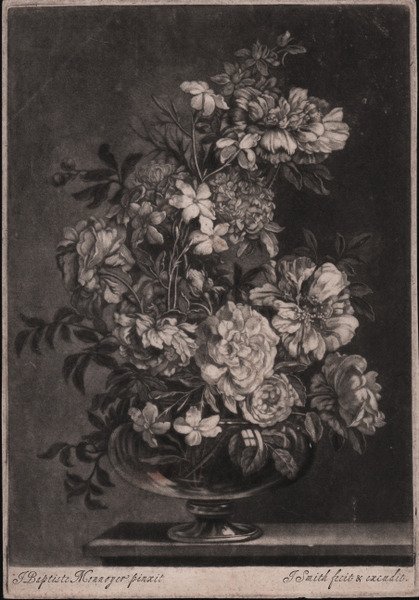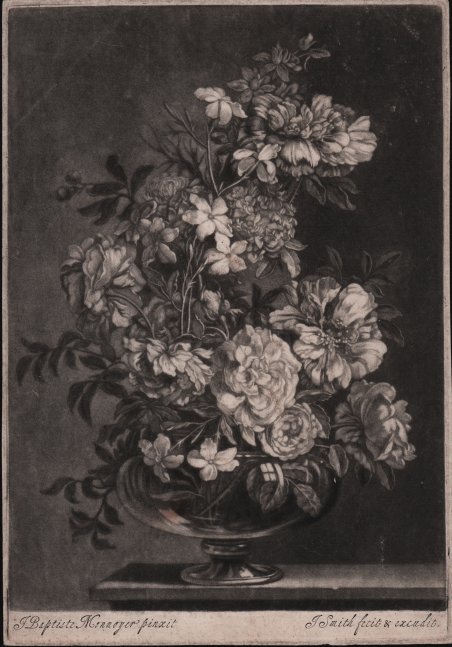Natura morta da tavolo con rose e altri fiori in un ampio vaso di vetro bombato, illuminata da sinistra. Da un dipinto di Jean Baptiste Le Monnoyer. Mezzotinto, 1691 circa, firmato sotto l'immagine "J Baptiste Monnoyer pinxit" e "J Smith fecit & excudit". Esemplare del secondo stato di tre, prima della rielaborazione con i ritocchi alla lastra. Buona impressione su carta vergata, con margini molto sottili, una piega obliqua della carta nell'angolo superiore sinistro, per il resto buone condizioni. Nagler indica per questa lastra la data del 1691. John Smith (1652-1743) fu un editore e stampatore dotato e ambizioso, la cui lunga carriera iniziò sotto il regno di Carlo II e si concluse dopo l'ascesa di Giorgio II. Nato nel Northamptonshire, lavorò a Londra, specializzandosi nella tecnica relativamente nuova del mezzotinto. Tra il 1683 e il 1729 produsse oltre trecento stampe. La raffinatezza e la "modernità" delle sue stampe gli procurarono fama e poi prosperità materiale. Smith apprese la tecnica del mezzotinto dal tipografo Isaac Beckett (1653-88 circa) e dall'artista olandese Jan Van der Vaart (1653-1727). Riprodusse anche opere di alcuni artisti contemporanei britannici e stranieri. Secondo il curatore del British Museum questo è la sequenza degli stati: (i) con la scritta "J Baptiste Monnoyer pinxit". (ii) scritta "J Baptiste Monnoyer pinxit // J Smith fecit & excudit". (iii) come sopra, ma con lastra ritoccata. L'opera è molto rara; le altre impressioni conosciute sono: Londra BM, 1876,1111.21 (ii); Parigi BN (i, ii); Chatsworth (ii, 2 impressioni); Cambridge Fitzwilliam (ii); Glasgow Hunterian (ii); Haddington albums (ii); Londra NPG (ii); New York PL (riedizione Boydell; Stuart Collection 226); Oxford Christ Church (ii); Amsterdam RPK (ii); Londra V&A (ii); CLB (3 impressioni, ii). Al verso della stampa firma della collezione di Giuseppe Storck (Lugt 2291), più altro timbro di collezione sconosciuto a Lugt. Bibliografia Antony Griffiths, Early Mezzotint Publishing in England I John Smith, 1652-1743, in “Print Quarterly”, VI 1989 pp. 243-57; Wessely, John Smith: Verzeichniss seiner schabkunstblätter, n. 482; Chaloner Smith, British Mezzotinto portraits from the introduction of the art to the early part of the present century (undescribed); Nagler, Neues allgemeines Künstler-Lexikon n. 500. Table-top still-life with roses and other flowers in a wide, rounded glass vase, lit from the left; after Monnoyer. Mezzotint, circa 1691, lettered below image with 'J Baptiste Monnoyer pinxit' and 'J Smith fecit & excudit.' Example of the second state of three, before the plate reworked. A good impression on laid paper, with very thin margins, an oblique paper crease at upper left corner, otherwise good condition. Nagler gives the date 1691 for this plate. John Smith (1652-1743) was a gifted and ambitious printmaker and publisher whose long career began in the reign of Charles II and closed after the accession of George II. He was born in Northamptonshire and worked in London, specializing in the relatively new technique of mezzotint printing. Between 1683 and 1729 he produced over three hundred prints. Trained as a printmaker he was able to retain a controlling hand when, in the early 1690s, he turned from pure printmaking to printmaking and publishing. The refinement and 'modernity' of his prints brought him fame and then material prosperity and Smith's career, largely independent of interference from outside publishers, must have been an inspiration to William Hogarth (1697-1764) and the next generation of printmakers. Smith learnt the technique of mezzotinting from the printmaker Isaac Beckett (c.1653-88) and the Dutch artist Jan Van der Vaart (1653-1727). Smith also reproduced works of a number of contemporary British and foreign artists. According to the curator of The British Museum this is the list of states: (i) lettered 'J Baptiste Monnoyer pinxit' (ii) lettered 'J Baptiste Monnoyer pinxit // J Smith fecit & excudit.' (iii) lettering as above; plate reworked.). The work is very rare; the other known impressions are: London BM, 1876,1111.21 (ii); Paris BN (i, ii); Chatsworth (ii, 2 impressions); Cambridge Fitzwilliam (ii); Glasgow Hunterian (ii); Haddington albums (ii); London NPG (ii); New York PL (Boydell reissue; Stuart Collection 226); Oxford Christ Church (ii); Amsterdam RPK (ii); London V&A (ii); CLB (3 impressions, ii). Collection mark of Giuseppe Storck (Lugt 2291). Bibliografia Antony Griffiths, Early Mezzotint Publishing in England I John Smith, 1652-1743, in “Print Quarterly”, VI 1989 pp. 243-57; Wessely, John Smith: Verzeichniss seiner schabkunstblätter, n. 482; Chaloner Smith, British Mezzotinto portraits from the introduction of the art to the early part of the present century (undescribed); Nagler, Neues allgemeines Künstler-Lexikon n. 500. Cfr.


Scopri come utilizzare
Scopri come utilizzare

